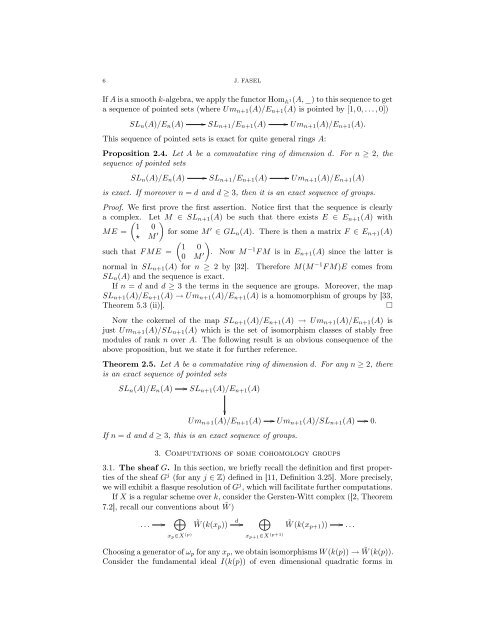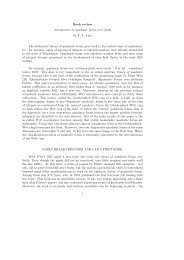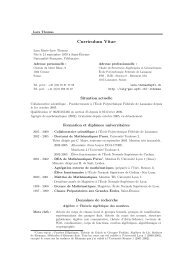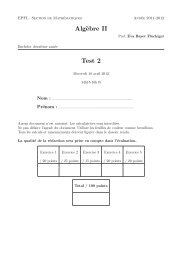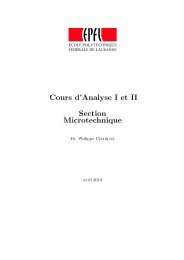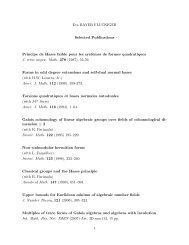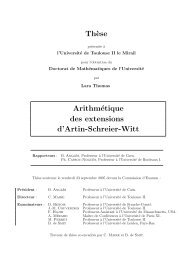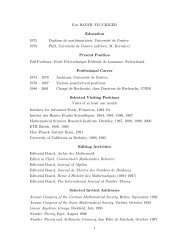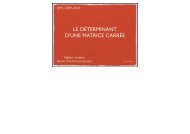Some remarks on orbit sets of unimodular rows - CSAG - EPFL
Some remarks on orbit sets of unimodular rows - CSAG - EPFL
Some remarks on orbit sets of unimodular rows - CSAG - EPFL
You also want an ePaper? Increase the reach of your titles
YUMPU automatically turns print PDFs into web optimized ePapers that Google loves.
6 J. FASEL<br />
If A is a smooth k-algebra, we apply the functor Hom A 1(A, _) to this sequence to get<br />
a sequence <strong>of</strong> pointed <strong>sets</strong> (where Umn+1(A)/En+1(A) is pointed by [1, 0, . . . , 0])<br />
SLn(A)/En(A)<br />
<br />
SLn+1/En+1(A)<br />
This sequence <strong>of</strong> pointed <strong>sets</strong> is exact for quite general rings A:<br />
<br />
Umn+1(A)/En+1(A).<br />
Propositi<strong>on</strong> 2.4. Let A be a commutative ring <strong>of</strong> dimensi<strong>on</strong> d. For n ≥ 2, the<br />
sequence <strong>of</strong> pointed <strong>sets</strong><br />
SLn(A)/En(A)<br />
<br />
SLn+1/En+1(A)<br />
<br />
Umn+1(A)/En+1(A)<br />
is exact. If moreover n = d and d ≥ 3, then it is an exact sequence <strong>of</strong> groups.<br />
Pro<strong>of</strong>. We first prove the first asserti<strong>on</strong>. Notice first that the sequence is clearly<br />
a complex. Let M ∈ SLn+1(A) be such that there exists E ∈ En+1(A) with<br />
1 0<br />
ME =<br />
⋆ M ′<br />
<br />
for some M ′ ∈ GLn(A). There is then a matrix F ∈ En+1(A)<br />
<br />
1 0<br />
such that F ME =<br />
0 M ′<br />
<br />
. Now M −1F M is in En+1(A) since the latter is<br />
normal in SLn+1(A) for n ≥ 2 by [32]. Therefore M(M −1F M)E comes from<br />
SLn(A) and the sequence is exact.<br />
If n = d and d ≥ 3 the terms in the sequence are groups. Moreover, the map<br />
SLn+1(A)/En+1(A) → Umn+1(A)/En+1(A) is a homomorphism <strong>of</strong> groups by [33,<br />
Theorem 5.3 (ii)]. <br />
Now the cokernel <strong>of</strong> the map SLn+1(A)/En+1(A) → Umn+1(A)/En+1(A) is<br />
just Umn+1(A)/SLn+1(A) which is the set <strong>of</strong> isomorphism classes <strong>of</strong> stably free<br />
modules <strong>of</strong> rank n over A. The following result is an obvious c<strong>on</strong>sequence <strong>of</strong> the<br />
above propositi<strong>on</strong>, but we state it for further reference.<br />
Theorem 2.5. Let A be a commutative ring <strong>of</strong> dimensi<strong>on</strong> d. For any n ≥ 2, there<br />
is an exact sequence <strong>of</strong> pointed <strong>sets</strong><br />
SLn(A)/En(A)<br />
<br />
SLn+1(A)/En+1(A)<br />
<br />
Umn+1(A)/En+1(A)<br />
If n = d and d ≥ 3, this is an exact sequence <strong>of</strong> groups.<br />
<br />
Umn+1(A)/SLn+1(A)<br />
3. Computati<strong>on</strong>s <strong>of</strong> some cohomology groups<br />
3.1. The sheaf G. In this secti<strong>on</strong>, we briefly recall the definiti<strong>on</strong> and first properties<br />
<strong>of</strong> the sheaf G j (for any j ∈ Z) defined in [11, Definiti<strong>on</strong> 3.25]. More precisely,<br />
we will exhibit a flasque resoluti<strong>on</strong> <strong>of</strong> G j , which will facilitate further computati<strong>on</strong>s.<br />
If X is a regular scheme over k, c<strong>on</strong>sider the Gersten-Witt complex ([2, Theorem<br />
7.2], recall our c<strong>on</strong>venti<strong>on</strong>s about ˜ W )<br />
. . .<br />
<br />
<br />
xp∈X (p)<br />
˜W (k(xp))<br />
d <br />
<br />
xp+1∈X (p+1)<br />
˜W (k(xp+1))<br />
<br />
. . .<br />
Choosing a generator <strong>of</strong> ωp for any xp, we obtain isomorphisms W (k(p)) → ˜ W (k(p)).<br />
C<strong>on</strong>sider the fundamental ideal I(k(p)) <strong>of</strong> even dimensi<strong>on</strong>al quadratic forms in<br />
<br />
0.


